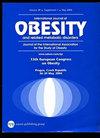Association of socioeconomic status with BMI differs by sex and position on BMI distribution among participants in the Cebu Longitudinal Health and Nutrition Survey (CLHNS)
IF 3.8
2区 医学
Q1 ENDOCRINOLOGY & METABOLISM
引用次数: 0
Abstract
To assess the association of variables representing the nutrition transition with BMI among young adults in a dynamic urbanising area in the Philippines; to test whether the roles of these variables were constant across the BMI distribution; and whether these patterns differed by sex. Data from the Cebu Longitudinal Health and Nutrition Survey rounds in 2002 (n = 1940), 2005 (n = 1802), 2009 (n = 1621), and 2018 (n = 1267) were used to assess BMI among young adults (ages 21–35 years). Main exposures included socioeconomic status (SES) represented by a lagged household asset index and urbanicity, and current education level. Models were stratified by sex and adjusted for employment status and parity in females. Quantile regression was used to examine the relationship between these variables and BMI. Household asset index was highly correlated with male BMI, its coefficient increasing from 2005 to 2018 and differing between quantiles; its association with female BMI was only positive among parous women whose BMI was at 0.50 and 0.75 quantiles in 2005. We found no associations between urbanicity and BMI in males, but negative and positive associations at 0.25 and 0.75 quantiles in females in 2018, respectively. College education was negatively associated with BMI in females, with larger effect sizes at 0.75 quantile, but positively in males at 0.25 and 0.50 quantiles in 2018. Associations of SES-related variables with BMI vary along BMI distribution and differ among male and female young adults in Cebu, Philippines. Males exhibit a pattern more characteristic of lower- or middle-income country (LMIC) settings than females, whose trends are more akin to those observed in high-income countries (HICs). Results will inform a more detailed inquiry into more proximal factors determining BMI.

宿雾纵向健康和营养调查(CLHNS)参与者的BMI分布中,社会经济地位与BMI的关系因性别和位置而异。
目的:评估菲律宾动态城市化地区年轻人中代表营养转变与BMI的变量之间的关联;检验这些变量在BMI分布中的作用是否恒定;以及这些模式是否因性别而异。方法:利用2002年(n = 1940)、2005年(n = 1802)、2009年(n = 1621)和2018年(n = 1267)宿务纵向健康和营养调查轮次的数据评估年轻人(21-35岁)的BMI。主要暴露因素包括以滞后的家庭资产指数和城市化程度为代表的社会经济地位(SES)和当前教育水平。模型按性别分层,并根据女性的就业状况和平等进行调整。分位数回归用于检验这些变量与BMI之间的关系。结果:家庭资产指数与男性BMI高度相关,其系数在2005 - 2018年呈上升趋势,分位数间存在差异;其与女性体重指数的关系仅在2005年体重指数在0.50和0.75分位数的产妇中呈正相关。2018年,我们发现男性的城市化程度与BMI之间没有关联,但女性的城市化程度与BMI之间分别呈0.25和0.75分位数的负相关和正相关。2018年,大学教育程度与女性的体重指数呈负相关,在0.75分位数处的效应值较大,但在男性中呈正相关,在0.25和0.50分位数处。结论:ses相关变量与BMI的相关性随BMI分布而变化,并且在菲律宾宿务地区的男性和女性年轻人中存在差异。与女性相比,男性表现出的模式更具有中低收入国家(LMIC)的特点,而女性的趋势更类似于在高收入国家(HICs)观察到的趋势。结果将为更详细地探究决定BMI的更近的因素提供信息。
本文章由计算机程序翻译,如有差异,请以英文原文为准。
求助全文
约1分钟内获得全文
求助全文
来源期刊

International Journal of Obesity
医学-内分泌学与代谢
CiteScore
10.00
自引率
2.00%
发文量
221
审稿时长
3 months
期刊介绍:
The International Journal of Obesity is a multi-disciplinary forum for research describing basic, clinical and applied studies in biochemistry, physiology, genetics and nutrition, molecular, metabolic, psychological and epidemiological aspects of obesity and related disorders.
We publish a range of content types including original research articles, technical reports, reviews, correspondence and brief communications that elaborate on significant advances in the field and cover topical issues.
 求助内容:
求助内容: 应助结果提醒方式:
应助结果提醒方式:


